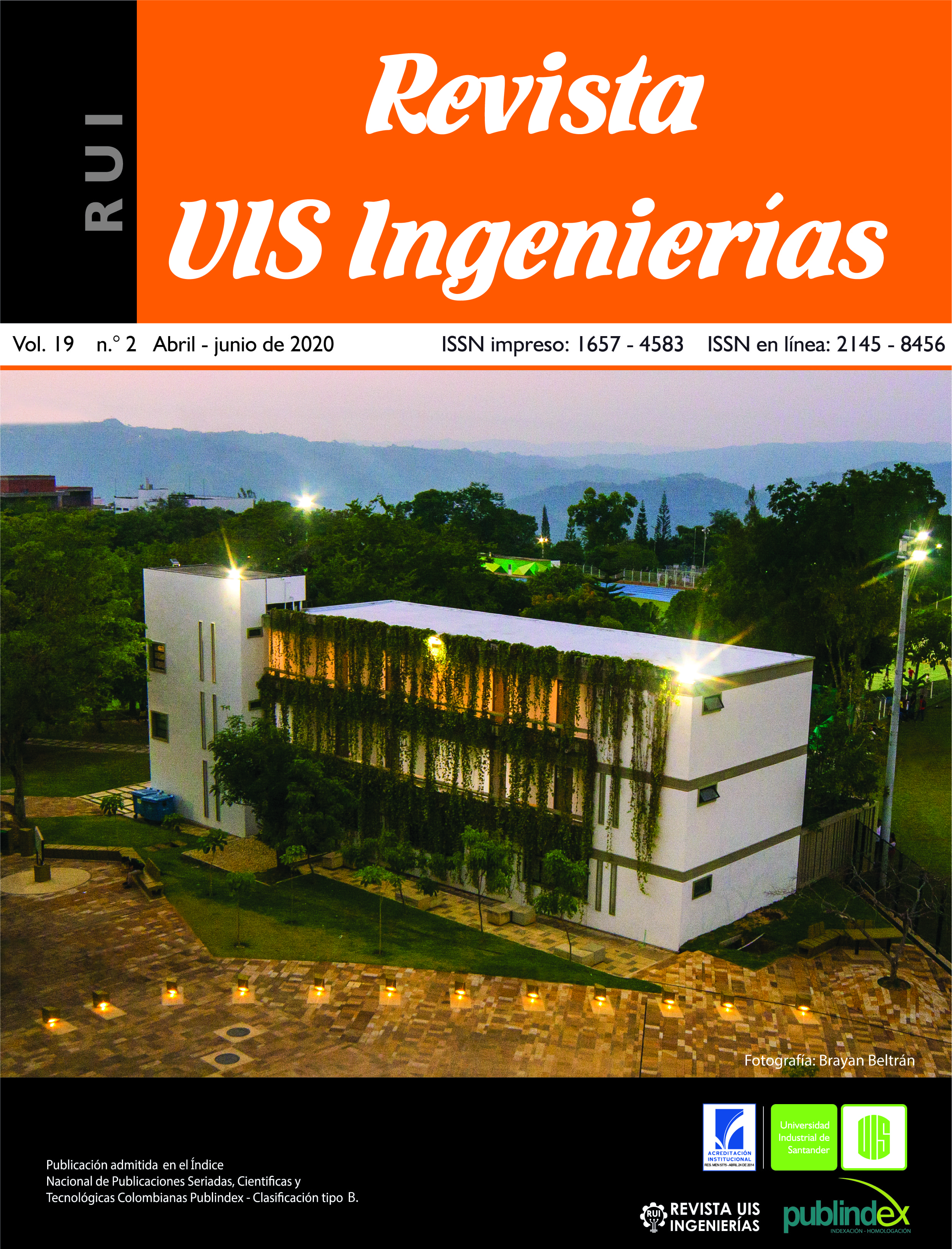Parametric evaluation of the main geometric variables in a not manned plane landing gear design by using the finite element method
Published 2020-03-30
Keywords
- landing gear,
- UAV,
- run,
- load factor,
- finite element method
How to Cite
Copyright (c) 2020 Revista UIS Ingenierías

This work is licensed under a Creative Commons Attribution-NoDerivatives 4.0 International License.
Abstract
The most important parameters in the design of a landing gear for drones are evaluated by using the finite element method. A tricycle configuration was selected because this is the most used model in this type of aircraft. Among the evaluated parameters are the thickness of the cross section (t), width (b), leg length (l), the angle ( ) between the leg of the undercarriage and the horizontal, materials, stroke (S), and load factor (N). From the evaluation of geometric parameters, it is observed that the thickness variation of the cross section t, and the angle formed between the leg of the landing gear and the horizontal, are inversely proportional to the vertical deformation and, therefore, directly proportional to the load factor N. On the other hand, the length variation of the landing gear leg behaves in the opposite way to the previous parameters. Regarding the evaluation of the materials, those with a lower elasticity modulus have better performance for this design type, less stiffness produces less stress at the impact moment, although it should be considered that a greater deformation is generated, resulting in a thickness increase of the cross section.
Downloads
References
[2] J. García, Terminología Aeronáutica, (1ª ed.). Madrid, España: Ediciones Díaz de Santos S.A, 2003.
[3] D. Raymer, Aircraft design: A Conceptual Approach, (2ª ed.). Washington, DC, USA: American Institute of Aeronautics and Astronautics, Inc., 1992.
[4] M.B.W. Graham, “Competition in England and the United States: the case of the aluminium dirigible” Business History Review, vol. 62, no. 2, pp. 261-285, 1988.
[5] I.M. Daniel, y O. Ishai, Engineering Mechanics of Composite Materials. New York, NY, USA: Oxford University Press, 1994.
[6] W. Watt, L.N. Phillips y W. Johnson, “High-strength high-modulus carbon fibres”, Engineer, vol. 221, no. 5757, pp. 815-816, 1966.
[7] M. Rosso, “Ceramic and metal matrix composites: Routes and properties”, Journal of Materials Processing Technology, vol. 175, no. 1-3, pp. 364-375, 2006.
[8] J. Corum, R. Battiste, K. Liu y M. Ruggles, Properties of Reference Crossply, Carbon-Fiber Composite. Oak Ridge, TN, USA: Lockheed Martin Energy Research Corporation, 2000.
[9] D. Morrison, G. Neff, and M. Zahraee, “Aircraft landing gear simulation and analysis,” in ASEE Annual Conference Proceedings, 1997.
[10] K. Shrotri, “Composite Skid Landing Gear Design Investigation”, trabajo especial de grado, Instituto de Tecnología de Georgia. Georgia, GA:, 2008.
[11] A Goyal y H. Laksminarayan, Design, Analysis and Simulation of a composite main landing gear for light aircraft. Coventry, Reino Unido: Centro de estudios de posgrado de la universidad de Coventry MSRSAS, 2008.
[12] Y. Park, K. Nguyen, J. Kweon y J. Choi, “Structural Analysis of a Composite Target-drone”, Int J. of Aeronautical & Space Sci. vol. 12, no. 1, pp. 84–9, 2011.
[13] A. Matta, G. Kumar, y R. Kumar, “Design Optimization Of Landing Gear’s Leg For An Un-Manned Aerial Vehicle”, International Journal of Engineering Research and Applications. vol. 2, pp. 2069-2075, 2012.
[14] C. Zhao, Y. Huang, Z. Chen, y S. Kyu Ha, “Progressive failure prediction of a landing gear structure of braided composites”, Composite Structures, vol. 161, pp. 407-418, 2017. doi: 10.1016/j.compstruct.2016.11.076
[15] B. Ferrandiz, M. Tur, y E. Nadal, "Simulación estructural de espumas de aluminio a partir de imágenes 2D mediante la combinación de técnicas de homogeneización y machine learning", Revista UIS Ingenierías, vol. 17, no. 2, pp. 223-240, 2018. doi: 10.18273/revuin.v17n2-2018020
[16] P. A. Chacón Santamaría, A. Sierra, y O. A. González-Estrada, "Shape optimization of a control arm produced by additive manufacturing with fiber reinforcement", Journal of Physics: Conference Series. vol. 1386, no. 1, pp. 012003, 2019. doi:10.1088/1742-6596/1386/1/012003
[17] A. Parsch, “Directory of U.S. Military Rockets and Missiles,” 2005. [Online]. Disponible: http://www.designation-systems.net/dusrm/.
[18] N. Currey, Aircraft Landing Gear Design: Principles and Practices, 1ª ed. Washington, DC, USA: Publicado por American Institute of Aeronautics and Astronautics, Inc., 1988.
[19] F. Beer, E. Johnston y J. Dewolf, Mecánica de Materiales. 3a ed. Mexico, DF: McGraw-Hill, Inc., 2001.
[20] Composite Materials Handbook, Volume 2. Virginia, VA, USA: Department of Defense, 1999.
[21] S. Lee, Handbook of Composite Reinforcements. New York, NY, USA: VCH Publisher, 1993.
[22] A. Inc., “Engineering Simulation & 3D Design Software | ANSYS,” 2018, 2018. [Online]. Disponible: https://www.ansys.com/

